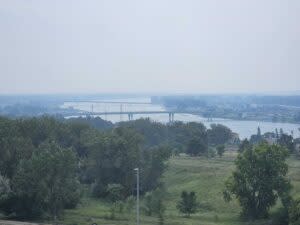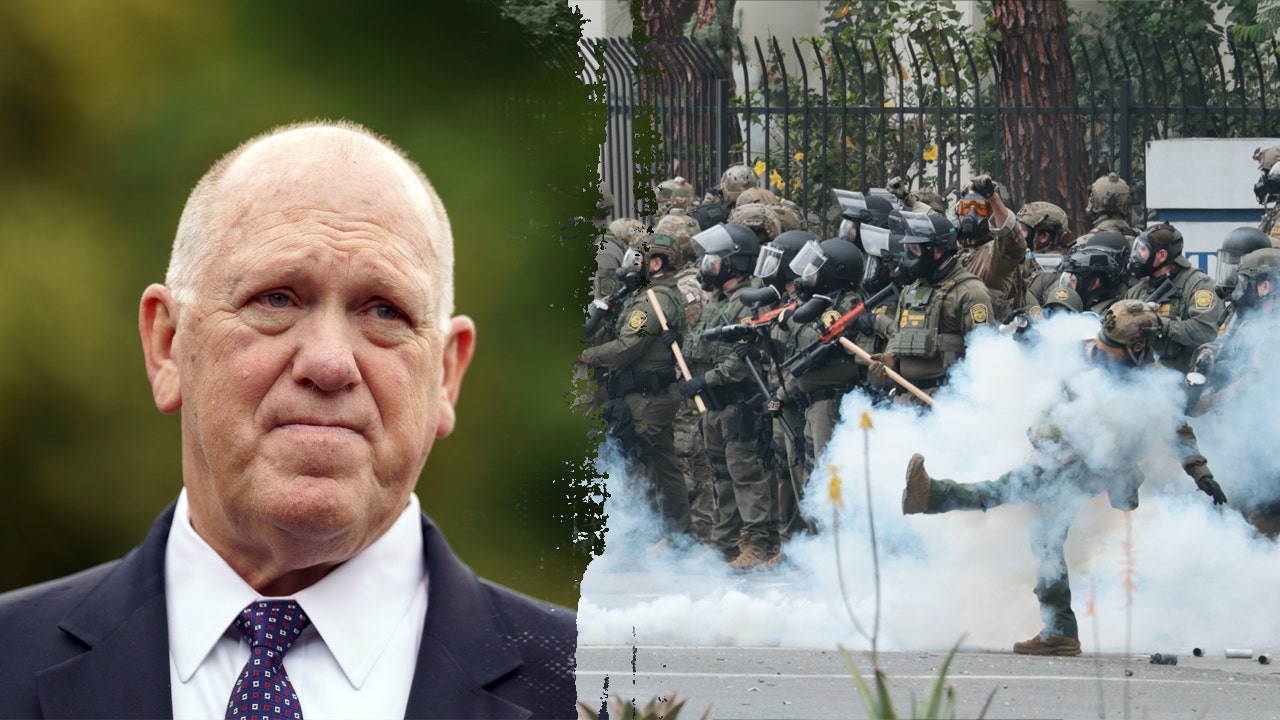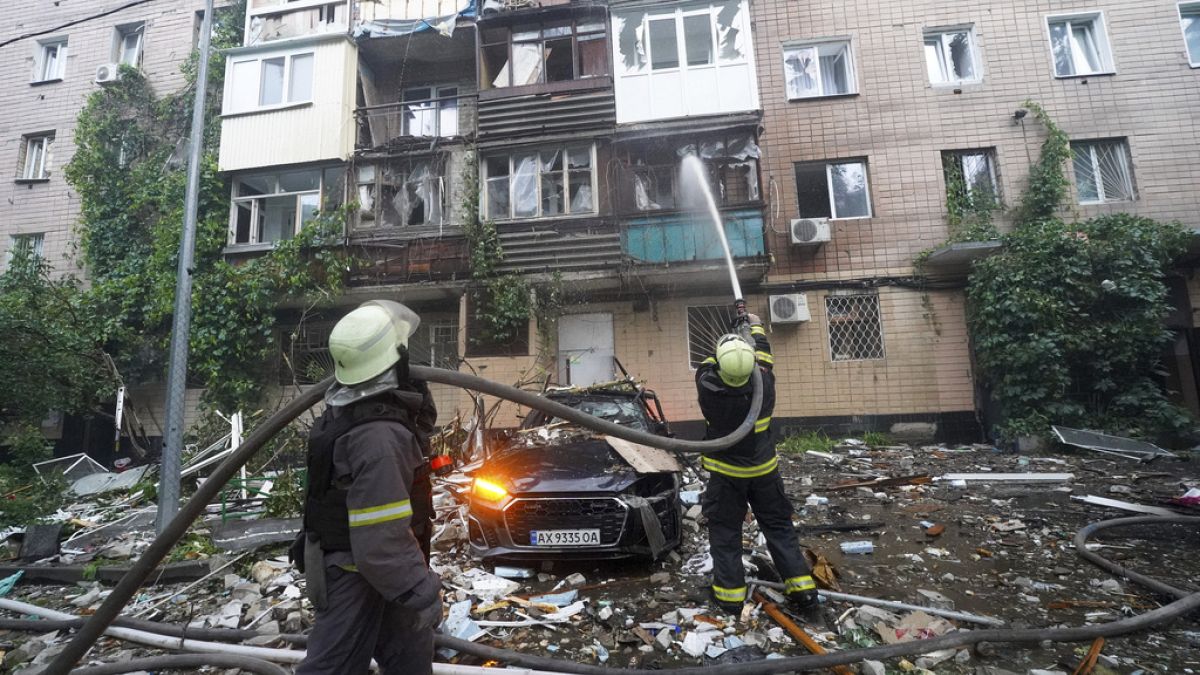North Dakota
EPA bureaucracy gets in the way of protecting environment, North Dakota official says

Jim Semerad, left, and Marty Haroldson of the North Dakota Department of Environmental Quality were part of a panel discussion Sept. 4, 2024, at a conference in Bismarck. (Jeff Beach/North Dakota Monitor)
Wildfire smoke wafted over North Dakota on Wednesday. For Jim Semerad of the Department of Environmental Quality, that will mean more work.
That’s because the department will have to show the federal Environmental Protection Agency that the smoke is actually coming from wildfires and not some other source of air pollution.
“We will go through a great deal of effort to prove something we already know,” said Semerad, who leads the department’s air quality division.
Semerad and others from the department were speaking Wednesday at a North Dakota Regional Environmental Conference in Bismarck. The conference was organized by the Air and Waste Management Association.

Semerad said staying on top of the ballooning amount of federal regulations can make it difficult for the agency to focus on what is really important — ensuring good environmental health.
The department sent a news release Wednesday morning advising the public of the air quality issues because of the wildfire smoke.
Semerad said EPA staff are well-intentioned but EPA bureaucracy gets in the way of protecting environmental quality.
“Our biggest problem might be the EPA,” Semerad said.
Chuck Hyatt, of DEQ’s waste management division, said one of the biggest roadblocks to working with the EPA is a lack of trust.
“They don’t necessarily trust what is going on in certain states,” Hyatt said. “And I wonder about that. Where does that come from?”
North Dakota has several ongoing legal battles with the EPA, including being the lead state challenging a mercury emissions rule that North Dakota officials have said threatens the state’s lignite coal industry.
Wednesday’s agenda included a session by Erik Wallevand, a lawyer in the North Dakota Attorney General’s Office, on tips for challenging federal regulations.
With factors such as federal regulations, retirements and other staff turnover, Semerad said something new for the department is struggling to keep up with clean air permits.
Semerad said there may be a request for more staff in the 2025 legislative session.
Semerad acknowledged that some of the workload comes from Mother Nature, with North Dakota being a state of extreme temperatures and weather and random events, such as wildfires.
“It’s kind of an invisible thing,” Semerad said of the work created by wildfires. “No additional inspections, no additional improvements to air quality. It’s just a reporting requirement.
“I guess that might be something that the Legislature needs to better understand.”
DONATE: SUPPORT NEWS YOU TRUST
SUBSCRIBE: GET THE MORNING HEADLINES DELIVERED TO YOUR INBOX

North Dakota
Obituary for Bonita Joy Olson at Tollefson Funeral Home

North Dakota
North Dakota AFL-CIO Elects New President – KVRR Local News

Ashley Gaschk is a middle school English teacher in Mandan.
BISMARCK, N.D. – The AFL-CIO in North Dakota has new leadership for the first time in six years.
Delegates to the North Dakota AFL-CIO convention elected Ashley Gaschk to a four-year term as President, Secretary-Treasurer – the top role in the state federation of labor unions.
Gaschk is succeeding outgoing president Landis Larson, who is retiring after 40 years of dedicated service to the labor movement – the last 6 of which were served as AFL-CIO president.
Gaschk said in part, quote, “Being a union member has improved my life in many ways, and I look forward to spending the next four years working to improve the lives of union members across our state.”
At the convention, the organization issued support for federal workers and United States Postal Service workers as well as opposition to Medicaid cuts.
North Dakota
Gaschk elected to lead ND AFL-CIO

Bismarck— Ashley Gaschk was elected to serve as the president and secreatary-treasurer of the North Dakota AFL-CIO at its convention.
“Being a union member has improved my life in many ways, and I look forward to spending the next four years working to improve the lives of union members across our state,” Gaschk said via news release. “On the job and in our communities, union members fight for fair pay and benefits, secure retirement, and expanded opportunities for all of North Dakota’s working families. I’m honored to have been elected and eager to get to work.”
Gaschk is an educator by trade, teaching middle school English in Mandan, N.D., since 2017. She is a member of the Mandan Education Association where she has served as a building representative, local union recording secretary, contract negotiator and delegate to the Missouri Slope Central Labor Council, AFL-CIO. Gaschk also taught in Minnesota, where she was a member of Education Minnesota. In addition to teaching, Gaschk worked as staff for the Transport Workers Union in the Legislative and Political Affairs department in Washington, DC. She later honed her organizing skills working as a field organizer for Working America, leading canvasses of union households in Minnesota.
Gaschk will replace Landis Larson, who is retiring after 40 years of service dedicated to the labor movement. He is a member of the International Association of Machinists local lodge 2525 and plans on staying active in the local labor movement. Larson served six years as North Dakota AFL-CIO president before announcing his retirement this spring.
“It’s been an honor to serve the labor movement. I’m proud of the work we’ve done and I know the future of the movement is in good hands” Larson said.
The North Dakota AFL-CIO convention also re-elected Deb Carter (United Steelworkers Local 560) as first vice president as well as Nick Archuleta (North Dakota United), Bob Wolf (International Brotherhood of Electrical Workers Local 714), and Dana Hillius (North Dakota United) as trustees.
The delegates to the 66th Annual North Dakota AFL-CIO convention passed resolutions in solidarity with federal workers, United States Postal Service workers and immigrant workers, as well as resolutions in support for Job Corp and in opposition to Medicaid cuts.
Our newsroom occasionally reports stories under a byline of “staff.” Often, the “staff” byline is used when rewriting basic news briefs that originate from official sources, such as a city press release about a road closure, and which require little or no reporting. At times, this byline is used when a news story includes numerous authors or when the story is formed by aggregating previously reported news from various sources. If outside sources are used, it is noted within the story.
-

 News1 week ago
News1 week agoVideo: Faizan Zaki Wins Spelling Bee
-

 News1 week ago
News1 week agoVideo: Harvard Commencement Speaker Congratulates and Thanks Graduates
-

 Politics1 week ago
Politics1 week agoMichelle Obama facing backlash over claim about women's reproductive health
-

 Technology1 week ago
Technology1 week agoAI could consume more power than Bitcoin by the end of 2025
-

 News1 week ago
News1 week agoPresident Trump pardons rapper NBA YoungBoy in flurry of clemency actions
-

 Technology1 week ago
Technology1 week agoSEC drops Binance lawsuit in yet another gift to crypto
-

 Technology1 week ago
Technology1 week agoOpenAI wants ChatGPT to be a ‘super assistant’ for every part of your life
-

 World1 week ago
World1 week agoTwo killed in Russian attacks on Ukraine before possible talks in Turkiye
















